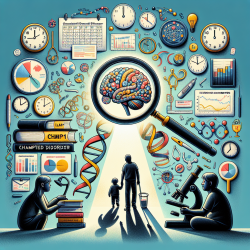Introduction
As practitioners dedicated to enhancing the lives of children, understanding the intersection of learning disabilities (LD) and anxiety is crucial. Research indicates that youth with LD are at a heightened risk for anxiety disorders, which can significantly impact their academic and social development. The study "Measuring Anxiety in Youth with Learning Disabilities: Reliability and Validity of the Multidimensional Anxiety Scale for Children (MASC)" provides valuable insights into assessing anxiety in this population.
Key Findings from the Research
The study investigated the psychometric properties of the MASC in a sample of adolescents with LD. It found that both child and parent reports on the MASC corresponded well with diagnoses from the Anxiety Disorders Interview Schedule (ADIS), particularly for social phobia. This highlights the MASC's utility as a reliable tool for assessing anxiety in youth with LD.
Why is This Important?
Understanding and accurately diagnosing anxiety in youth with LD is critical because emotional stability is a predictor of future success. Anxiety can exacerbate the challenges faced by these children, affecting their academic performance and social interactions. However, anxiety is often underdiagnosed in this population due to diagnostic overshadowing and the exclusionary nature of LD definitions.
Implementing the Findings
Practitioners can improve their assessment strategies by incorporating the MASC into their evaluations. Here are some practical steps:
- Use the MASC: Incorporate the MASC as part of a comprehensive assessment for children with LD to identify anxiety symptoms that might be overlooked.
- Multi-Informant Approach: Utilize both child and parent versions of the MASC to gain a comprehensive understanding of the child's anxiety profile.
- Training and Education: Educate school professionals about the importance of recognizing anxiety symptoms in children with LD to avoid misdiagnosis.
- Further Research: Encourage continued research into the reliability and validity of anxiety assessment tools in diverse populations.
Encouraging Further Research
While the study provides a strong foundation, further research is necessary to explore the MASC's applicability across different LD subtypes and cultural contexts. Practitioners should advocate for and participate in studies that expand our understanding of anxiety in youth with LD.
Conclusion
Incorporating data-driven tools like the MASC into practice can enhance the accuracy of anxiety diagnoses in youth with LD, leading to better-targeted interventions and improved outcomes. By understanding and addressing the unique challenges faced by these children, practitioners can play a pivotal role in their development and success.
To read the original research paper, please follow this link: Measuring Anxiety in Youth with Learning Disabilities: Reliability and Validity of the Multidimensional Anxiety Scale for Children (MASC).










